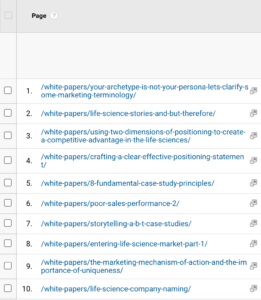5 Digital Marketing Trends You Need To Capitalize On In 2021
By Jordan Eller

The Forma team has just returned from (virtually) attending Digital Summit 2021, and we’re very excited to share some of the most important digital marketing trends that can help elevate your life science brand.
As you likely already know, digital marketing trends are constantly changing. Unfortunately, there is still a significant amount of life science organizations that still approach sales and marketing like it’s 2015.
So much has changed since then, and if you’re not paying attention to modern digital marketing trends, your business will be eclipsed by those who are more adaptable. Check out the list below, and let us know if you need a partner to help support your marketing goals in 2021 and beyond.
1) Everything is going digital
Trade shows aren’t coming back any time soon. The days of sitting down across from a prospect face-to-face are over. This is why you need to make an active effort to expand your digital footprint.
Start with your website. As your most important marketing tool, this should be a priority for your brand. Consider the user experience from the audience’s perspective:
- Does your site feature relevant, unique content?
- Is your site easy to navigate?
- Does your site perform well on mobile devices?
- How easy is it for your users to get in touch with you?
By shifting your focus to your online audiences, you are positioning your business for success in the digital world.
If you’re looking to lead the digital conversation with your users in 2021, check out our Digital Marketing Services and see how we can help you elevate your life science brand over your competitors.
2) No more “flying monkey” business
The “flying monkey” business was a term coined by Equifax’s Director of Content Strategy, Ashley Sansett. In her workshop, Ashley described the “flying monkey” business as the propensity to chase multiple random projects and initiatives at once without ever being able to focus on your core strengths as a brand.
We all know the downside of being a Jack of All Trades is that you’ll also be a Master of None. In the life sciences, it’s absolutely crucial that you cultivate a selection of offerings based on your expertise. If you continually get distracted by different, “shiny” things, consider realigning your organization around a core set of values and services that you’re confident you can deliver on.
3) It’s time to get Agile
Agile Methodology began in the software development world as a way to efficiently deliver solutions while also remaining adaptable to changing circumstances.
Agile is useful across a wide spectrum of industries, and the life sciences are no exception. The core tenets of Agile are:
- Individuals and interactions over processes and tools
- Working software over comprehensive documentation
- Customer collaboration over contract negotiation
- Responding to change over following a plan
The final point, responding to change, is a particularly challenging one in our industry. The life sciences are heavily regulated and comprised of scientists, doctors, engineers, and other technically-minded professionals. In our experience, scientists prefer following prescribed formulas and roadmaps to achieve their results, but unfortunately digital marketing doesn’t operate that way. Every roadmap will have bumps and twisting turns, and it’s more important to be able to react to them instead of following a rigid process.
By remaining Agile and adaptable, you’ll be able to react quickly to the inevitable challenges that arise during most digital marketing campaigns.
4) Content needs to be an organizational skill
It’s hard to call content strategy a “digital marketing trend” when it’s been such a crucial element of marketing success for so long. Still, the Forma team continues to encounter life science organizations that are in dire need of fresh, unique content. Why do so many companies struggle with this?
There are a few reasons. It’s possible that a business is brand-new and hasn’t built up a library of resources yet. Or, they believe their content isn’t a main driver for website traffic, so they gave up on it. Or it might be as simple as just not having enough time to continually create content.
The truth is that content needs to be a priority throughout your entire organization. Nearly every life science company has a host of subject matter experts who could leverage their expertise into compelling, authoritative content. However, this sort of change happens from the top-down. If you’re a leader in your organization, it is your responsibility to tap your subject matter experts for their wealth of knowledge and distill it into content for your audience.
We’ve got 30 years of experience in executing engaging Content Strategies for companies in the life sciences and healthcare. Check out our case studies to explore how we’ve helped companies just like yours.
5) Legacy content needs to be addressed
Developing a content strategy doesn’t just mean creating new content; it also means taking close look at the content that’s been published on your site for an extended period of time. One easy way to identify how your content is performing is to take a look at your Google Analytics data. Here’s a look at Forma’s most popular whitepapers:

Our most popular blog is from 2019. While digital marketing has changed quite a bit since then, it’s still a useful piece of content. However, we’ve got our fair share of old content that doesn’t drive engagement like it did in the past. So what should we do with it?
Everyone has a few options when it comes to deciding how to deal with the legacy content on their site. For the most part, it boils down to 3 choices:
- Keep the content as-is
- Update, refresh, or repurpose the content
- Unpublish the content from your site
This is where Google Analytics can help you. If you have an older piece of content that is still driving traffic, then it’s fine to leave it alone. However, if you have a pile of dusty old blogs that contain broken links or outdated content, it’s time to consider either refreshing them or unpublishing them. If there’s still some good information in older content, then the repurposing effort should be pretty straightforward. If it’s clearly not doing your brand any favors (ancient press releases, blogs about obsolete technology, etc.), then unpublishing it is probably the right call.
Keep in mind that every modern content management system allows developers to unpublish site pages without deleting them completely, so if you ever want to go back and salvage some older content, it will always be there.
These are only a handful of digital marketing trends that are being observed so far in 2021. Are you looking for support with your content strategy? Or maybe you’re ready to make your brand bigger and better than ever with a full rebranding initiative. Either way, the expert strategists at Forma are ready to support you however we can. Start a conversation today!





